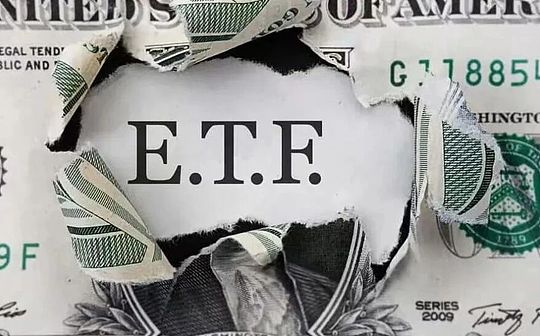
In June, one after another, after LayerZero, another star project, ZkSync, got the airdrop baton.
But unlike LayerZero, ZkSync airdrop did not adopt extremely strict witch screening, which was quite harmonious in the world, but there were ill-fated funding settings, doubtful rat warehouses, and excessively prominent rules for project discourse.It ushered in stronger community criticism and boycott.
Despite the face of community disputes and various controversies, exchanges such as Binance and Bitget have announced their launch of ZK one after another, and the weakening of prices has also caused ZK to be involved in a larger vortex of public opinion.
It seems that ZkSync, which claims to be the last hope for L2, seems to disappoint users the most.
Compared with LayerZero, which was previously airdropped, ZkSync has a higher popularity and a longer history as the Ethereum L2 star “F4”, which is as famous as Arbitrum, Optimism and starknet.
zkSync was first derived from EthCC in 2019, and the team is committed to jointly developing and deploying Rollup with zkSNARK.At the beginning of 20 years, with the outbreak of Defi, the Ethereum ecosystem flourished, and the scalability issue became increasingly prominent.At that time, the Rollup solution was an industry consensus on Ethereum’s expansion technology path, but the fraudulent proof adopted by OP had its natural defects of waiting time and centralized verification. Therefore, ZK Rollup, which has more cryptographic characteristics and uses zero-knowledge proof, became a technical worker.zkSync is also born.
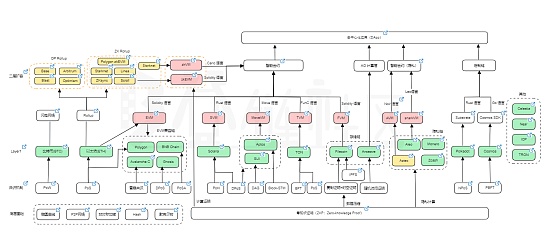
Web3 technology map, source: Denglian Community
In June 2020, zkSync parent company Matter Labs officially released zkSync v1.0 version on the Ethereum main network. By introducing ZK Rollup, the process of generating proof is output using the zero-knowledge proof circuit. The zkSync verifier has no right to perform any operations on user assets.This eliminates some of the risks brought by centralized validators, improves data availability, and brings more efficient and scalable technical solutions.zkSync has thus become one of the most optimistic projects of Ethereum founder V God.
From a technical perspective, zkSyn has significant advantages in terms of security and efficiency compared to OP Rollup, but it also has core problems – the algorithm is complex, the engineering is difficult, and the compatibility is also worse. In this context, zkSync is not consideredRapid development.
In June 2021, the zkSync 2.0 test network Era was released, and it was not until two years later that the ZkSync main network was officially launched in March 2023.But ZkSync became a hit with becoming the first open source mainnet zkEVM deployed in the Ethereum Rollup ecosystem.Just two months after its launch, ZkSync Era mainnet TVL reached US$480 million, with a weekly growth rate of nearly 20%. The number of independent addresses has reached 920,000, surpassing other Layer 2 networks such as Arbitrum, Optimism and Starknet at that time.
Capital will naturally not miss this type of project.In fact, the team behind zkSync, Matter Labs, is originally from the world’s top companies and is closely linked to capital. According to public data, the project has raised US$258 million through five rounds of financing since 2018, and is well-known such as a16z, Dragonfly and Blockchain Capital.All capitals have endorsements.
Top capital, potential track and star projects, this superposition naturally makes users full of hope for their token airdrops, not to mention that OP, ARB, and STARK have previously built their own token systems, with a total of more than US$3.4 billion airdrops.tokens.Under this expectation, despite the weak ZK ecosystem, a large number of users naturally poured into zkSync, and the project has repeatedly staged a wolf, and some users even joked that “the king of airdrop pua.”
The data is exactly the same. According to Dune data, the average number of ETHs bridged by users is only 1.37, and more than 80% of users have less than 1ETH, and only 1.3% of the address balance exceeds 10 ETH. It can be seen that the main user of zkSync is still Benz.Come in airdrop, not users of large funds.
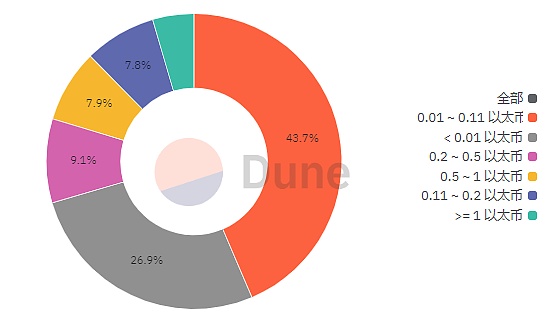
ZKsync bridge fund usage range distribution, source: Dune
This year, the airdrop has finally arrived.On June 11, ZKsync announced that it will airdrop 3.6 billion ZK tokens at one-time to early users and adopters of zkSync on June 17, with 695,232 eligible wallets.The snapshot is March 24, and community members can check empty investment spaces on the Claim.zknation.io website and can claim airdrops from the 17th until January 3, 2025.A single address that meets the criteria can also get a minimum of 450ZK, with a maximum limit of 100,000 ZK.
It should have been a good thing, but the airdrop details and subsequent events gave users a blow.From the perspective of the entire quota composition, there are three major parts of airdrops: one is qualification review, the second is basic allocation, and the third is multiplier effect.
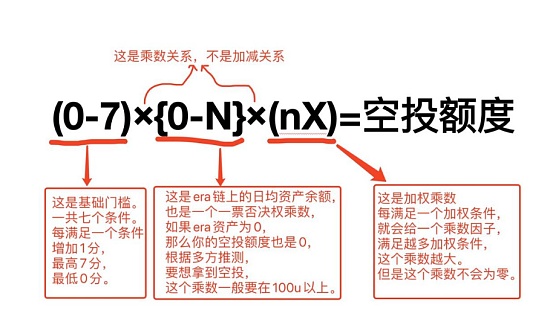
ZKsync airdrop formula, source: Bale
From the perspective of qualification review, the short investment range is not strict. Although the thresholds such as having NFT and having interactions are complex, they are mostly basic operations.But from the perspective of distribution, there is knowledge.ZKsync innovation has added the threshold for fund retention, no longer using common cross-chain standards such as monthly active users, transaction volume, and tx quantity, but more like pledge project requirements.Fund retention means that large funds can naturally obtain more allocations, because from the formula, accounts with a large airdrop quota will either be retained for a long time or have a large balance of funds, which is better for both.In the multiplier terms, the 5 multipliers are more stringent and difficult to figure out, and are almost tailor-made for rat warehouses.
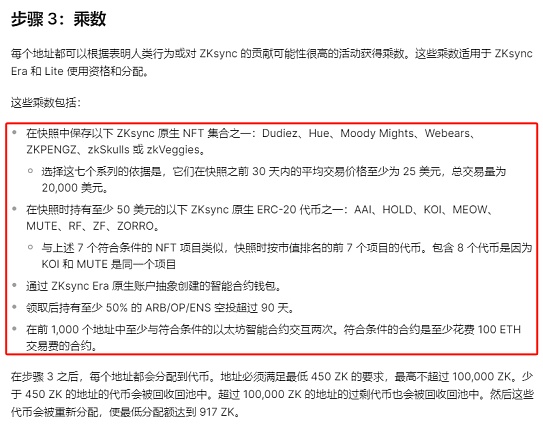
It can be seen that it is extremely difficult to get the ZKsync airdrop even without a witch, which directly led to the wool party, who thought he was sure to win, instantly evolved into a large-scale anti-rat defense battle.According to Seanzhao1105 of X platform, it used 6,000 accounts, 400 manual numbers and 5,600 program numbers, with a total investment of 200,000 US dollars, and finally got only 35 addresses.This is not false. From the perspective of address, only 690,000 addresses received airdrops, accounting for only 10% of the total address. Before the airdrop, TrustGo, Nansen and other institutions predicted that it might be possible to obtain airdrops of up to 1.6-2 million addresses, and moreRidiculously, even multiple projects in the zkSync ecosystem said that they did not receive any airdrops.
On the other hand, ZKsync’s words on the airdrop application interface also triggered a conflict that was imminent.”Satisfaction of one or more of the above airdrop standards does not mean obtaining legal rights or requirements for airdrops. All decisions related to airdrop allocation are at the discretion of the ZKsync Association.” A brief translation means that the final interpretation is subject to the project party.This kind of behavior that is not Web3 is difficult to avoid touching the user’s reverse scale. For a time, the community began to condemn ZKsync in various ways.
What’s even more terrifying is that the broad witch standard boomerang is once again stuck on ZKsync.Since Layerzero’s witch library was not adopted, the ZKsync airdrop witch addresses have increased dramatically.Witch Hunter Artemis analyzed in the statistical table that witch users who made $4.2 million in Arbitrum airdrop still have available investment space; some witch accounts marked on the LayerZero witch list deposited the same amount of Ethereum funds on the same day,It also obtained more than 2 million ZK tokens, and each wallet received an average of 15,000 ZK tokens, while the average distribution of ordinary users was only 5,286, far lower than the witch address.Further analysis of the airdrop address obtained will reveal that the account is quite concentrated. According to community statistics, 9,203 addresses have obtained a total airdrop of 23.9%.
Faced with various doubts, the project responded to the airdrop details and the witch, updated the FAQ document, and added a feedback email accordingly.But in this context, community criticism still reached its peak, with the community saying it will boycott the token and strongly calling on exchanges not to launch ZK tokens either.
However, the final result was contrary to expectations.
On June 17, ZKsync (ZK) airdrop officially opened for application at 15 o’clock.As of 5 p.m., according to data released by ZKNation, more than 225,000 addresses received more than 45% of the airdrop ZK tokens in less than 2 hours.
Immediately afterwards, Binance announced that it will launch ZKsync (ZK) at 16:00 and open the spot trading pairs of ZK/BTC, ZK/USDT, ZK/FDUSD, and ZK/TRY.Meanwhile, ZK withdrawal is expected to open at 16:00 on June 18.After Binance, Bithumb and Bitget announced that they will launch ZK tokens.
Data shows that the opening on the ZK chain hit a maximum of US$0.4236, which has fallen back by US$0.29 after it went online, and fell 30% after it went online.Perhaps affected by this, Binance and Bitget both announced the postponement of ZK..Currently, ZK is online on Bitget and Binance. Bitge opens at $0.34 and is now quoted at $0.26, while Binance opens at $0.295 and is now quoted at $0.26, which is much lower than previous market expectations.
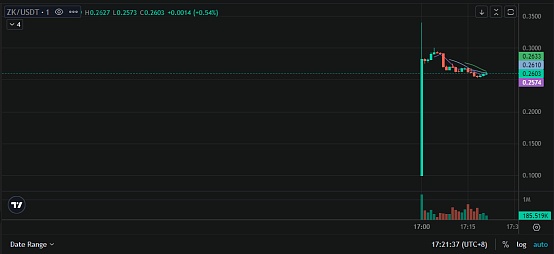
Although the community has complained about this, from the perspective of the exchange, it is understandable to launch large-scale tokens.Exchanges need traffic and need to be listed first to occupy the market. No matter how controversial ZK is, it cannot deny its star status. Judging from the total amount of tokens alone, ZK’s 3.6 billion token airdrop volume is actually much larger than OP and ARB.with STARK.
On the other hand, there are also many hair fuckers who have obtained large-scale airdrops and have begun to carnival.The final result of this benefit is just like before, with joy and sorrow coexisting.
In reviewing this airdrop battle, although ZKsync has problems such as transparency, its funds retention still left a profound impact on subsequent airdrops.Based on the original transaction frequency, transaction volume, monthly activity, contract number and balance, the subsequent retention time and balance are expected to be further added to the airdrop standard.In the long run, the decrease in airdrop odds, the increase in complexity, and the increase in investment will become inevitable trends. Regardless of whether admitted or not, the change in the personal airdrop threshold is predictable.andRegarding the industry’s problems such as rat warehouse and witches, ZKsync has already operated, this time, it has also opened up the fig leaf, and the consequences brought by other projects can be regarded as a typical negative case.
On the other hand, for ZKsync, airdrops are just the beginning, and ecological issues and profit capabilities are the key points to focus on.From a point of time, zkSync’s token issuance this year also feels like he is losing his skills. Although TVL seems to have made a lot of money and GAS’s revenue is also full of money, its profit-capturing ability is facing a significant decline.
Compared with OP, ARB, etc. with better network effects, zkSync has obvious ecological difficulties. Although there are more than 243 projects, they lack top DAPPs, and the fields are highly concentrated in DEX and lending. Only 4 zkSync projects have TVLs of more than 1,000.Ten thousand US dollars, accounting for nearly 66% of the overall locked position.The absolute revenue big-head Gas also showed a continuous downward trend this year, with the cost captured in April falling by about 88.9% from January, and after the airdrop, zkSync’s daily new addresses are also rapidly decreasing.In addition, with the gas after Ethereum upgrade, zkSync transaction costs also declined. Officials revealed that there will be a decrease of about 10-20 times, which means that profitability will face test again.

The ultimate airdrop move has been used, and the user has been injured, but the time left for ZKsync may not be as abundant as he imagined.





